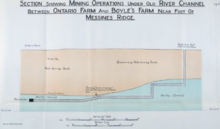Mines in the Battle of Messines (1917)
Detonation of explosives by British forcesSeveral underground explosive charges were fired during the First World War at the start of the Battle of Messines (7–14 June 1917). The battle was fought by the British Second Army and the German 4th Army near Mesen in Belgian West Flanders. The mines, secretly planted and maintained by tunnelling companies of the Royal Engineers beneath the German front position, killed many German soldiers and created 19 large craters.
Read article
Top Questions
AI generatedMore questions
Nearby Places

Battle of Messines (1914)
Part of the Western Front in World War I

Messines Ridge (New Zealand) Memorial
WW1 memorial in Belgium
Croonaert Wood
Forested area in Belgium

Wulverghem
Village in Flemish Community, Belgium
Sint-Elooi
Village in West Flanders, Belgium

Actions of St Eloi Craters

Spanbroekmolen
Farming region in Belgium

Messines Ridge British Cemetery
WWI CWGC cemetery in Belgium












